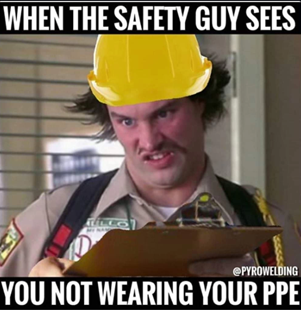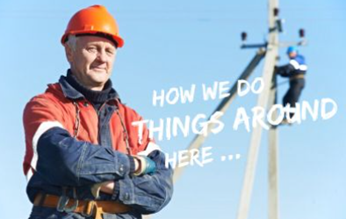Culture Silences in Safety – Memes
Another article from the ‘Culture Silences’ Series by Dr Rob Long – see them all HERE
 It is not unusual to receive responses from safety people that propose that an idea, research or presentation is ‘nonsense’. This quote from my post on Socialitie is typical:
It is not unusual to receive responses from safety people that propose that an idea, research or presentation is ‘nonsense’. This quote from my post on Socialitie is typical:
‘Martin Buber? Good grief!
“There is no such thing as an individual, we are all individuals-in-relation.” – Nonsense. Seems like we have here psychological academia intruding on the world of risk again.’
Of course, it would be clear that this safety person has never read Buber, one of the most radical Philosophers in the past 200 years (https://plato.stanford.edu/entries/buber/). It is also clear that the nature of social reality is quickly dismissed as ‘academia’ which serves as a ‘meme’ in safety to dismiss thinking and project the value of ignorance.
Unfortunately, there is no curriculum in safety globally that entertains the idea of critical-thinking by philosophy, such is the nature of an industry bound to the mono-disciplinary worldview of Engineering and safety as counting. In any Education Curriculum globally, Philosophy of Education is considered foundational. Such is the nature of the teaching profession.
Philosophical critical thinking ought to be foundational for any safety person. Not lest of all, to understand the worldview that drives safety.
So, with philosophy and worldviews in mind, let’s consider for a moment the view by Richard Dawkins that ‘memes’ act like genes in the replication of culture. Evolutionary biologist Richard Dawkins introduced the meme in his book The Selfish Gene (https://alraziuni.edu.ye/uploads/pdf/The-Selfish-Gene-R.-Dawkins-1976-WW-.pdf).
Now, we don’t have to agree with Dawkins to appreciate his thinking, intelligence and expertise in biology, philosophy and critical thinking (https://www.edge.org/memberbio/richard_dawkins). Just because one doesn’t agree with a philosophy or an idea doesn’t mean it is ‘nonsense’. Indeed, such is the poverty of compliance and closed thinking in the industry of safety. We also see the same approach to Dawkins’ atheism by religious fundamentalists.
Dawkins was not just an academic, his thinking was very practical. This idea that because an academic speaks something makes it irrelevant simply promotes binary and closed thinking that values ignorance and declares intelligence as ‘nonsense’. Dawkins was concerned with the outcomes of creationist and intelligent design thinking, also with anti-rationality, fundamentalism and anti-science. What Dawkins warned against was the dumbing down of society and how memetic thinking replicated ignorance. This has huge implications for the way we educate and enculturate society. Dawkins (1989) writes:
‘just as genes propagate themselves in the gene pool by leaping from body to body via sperms or eggs, so memes propagate themselves in the meme pool by leaping from brain to brain via a process which, in the broad sense, can be called imitation. (p. 192).’
Dawkins envisioned the meme as a cultural unit (or idea) that sought replication for the purpose of its own survival. Ideas as memes are inherently selfish and virulent he stated, competing to infect individual minds to use them as vehicles for replication. These can be slogans, mantras, phrases, fashion, songs, jingles, symbols, video etc. that have a different ‘rhythm’ and ‘stance’ than just text-based communication. For Dawkins, the meme served as a catalyst for cultural jumps in human evolution, much like a gene served to further biological evolution. We certainly see this in Twitter, Facebook, Youtube, Tiktok and Instagram where memes are passed on with a scroll and a click, where links are never read and TBTR text (Too Big To Read) are forwarded without thinking.
Remember the video Gangnam Style? a music video featuring South Korean musician Psy. The video has been viewed over 3 billion times since it was uploaded to YouTube on July 12, 2012. Such is the power of a self-replicating meme. The same mentalitie promoted Dumb Ways to Die (237 million views) as somehow an intelligent explanation of why people suicide by train (https://safetyrisk.net/dumb-ways-to-die-doesnt-work/). Then seek to justify validity by number of clicks, such is the ignorance of this DWTD safety meme. Miley Cyrus parading nude on a wrecking ball was released the same week and has 1.3 billion views.
The idea of the meme as cultural energy is certainly worth consideration in an understanding of culture, particularly with how we see internet memes project and replicate themselves by the millions and billions. Blackmore has argued in The Meme Machine that Memetics ought to be its own Discipline for research. According to Blackmore, memes have their own ‘consciousness’. That is, they have their own unique psychic energy that exists between people and in populations to replicate themselves. We experience this often when we see memes go ‘viral’. Just as a virus like COVID19 can be personified (to have a Mind of its own) so too, can a meme have its own energy that motivates its replication. This epidemiological approach to cultural ideas certainly makes sense. Well before the Internet, Jung also understood the way in which ideas, with their own psychic energy and consciousness, replicate themselves.
 All of this makes the silly safety behaviourist meme ‘what we do around here’ for explaining culture look rather pathetic. Similarly, the replication of the zero meme with no thought to its religiosity (https://safetyrisk.net/the-spirit-of-zero/) and denial of fallibility (https://www.humandymensions.com/product/fallibility-risk-living-uncertainty/). So many just declare that ‘zero works’ (https://visionzero.global/ ) when of course it doesn’t and then Safety replicates this dangerous idea that promotes brutalism. Such is the safety code (https://safetyrisk.net/deciphering-safety-code/) where Safety declares what it is by its opposite. It is by memes that such replication and spread is enabled. We also see this in so called ‘Safety Differently’ movement that has slogans as memes but neither a Methodology or method (https://safetyrisk.net/the-safety-and-new-view-debate/). So, as an idea it is not ‘different’ methodologically.
All of this makes the silly safety behaviourist meme ‘what we do around here’ for explaining culture look rather pathetic. Similarly, the replication of the zero meme with no thought to its religiosity (https://safetyrisk.net/the-spirit-of-zero/) and denial of fallibility (https://www.humandymensions.com/product/fallibility-risk-living-uncertainty/). So many just declare that ‘zero works’ (https://visionzero.global/ ) when of course it doesn’t and then Safety replicates this dangerous idea that promotes brutalism. Such is the safety code (https://safetyrisk.net/deciphering-safety-code/) where Safety declares what it is by its opposite. It is by memes that such replication and spread is enabled. We also see this in so called ‘Safety Differently’ movement that has slogans as memes but neither a Methodology or method (https://safetyrisk.net/the-safety-and-new-view-debate/). So, as an idea it is not ‘different’ methodologically.
This idea of memes is not something one finds in a discussion on culture and safety. Yet, there are many safety memes (https://safetyrisk.net/safety-memes/) that also have a presence on most social media (https://www.facebook.com/WorkplaceSafetyMemes/; https://cheezburger.com/15506949/workplace-safety-memes-for-the-responsible-coworkers-out-there; https://memes.com/tag/safety). A search for ‘safety memes’ brings up 27 million results.
These not only validate the idea of a ‘meme’ but also help Safety participate in dumbing down itself. Yet, there is no discussion of the concept of a meme itself. That is, there is no intelligent discussion about the power of a mem itself. This is how Safety helps replicate simplistic binary ideas to help keep the industry unprofessional. It’s just like talking about learning without defining learning or discussing ‘work as imagined’ without talking about imagination.



Do you have any thoughts? Please share them below